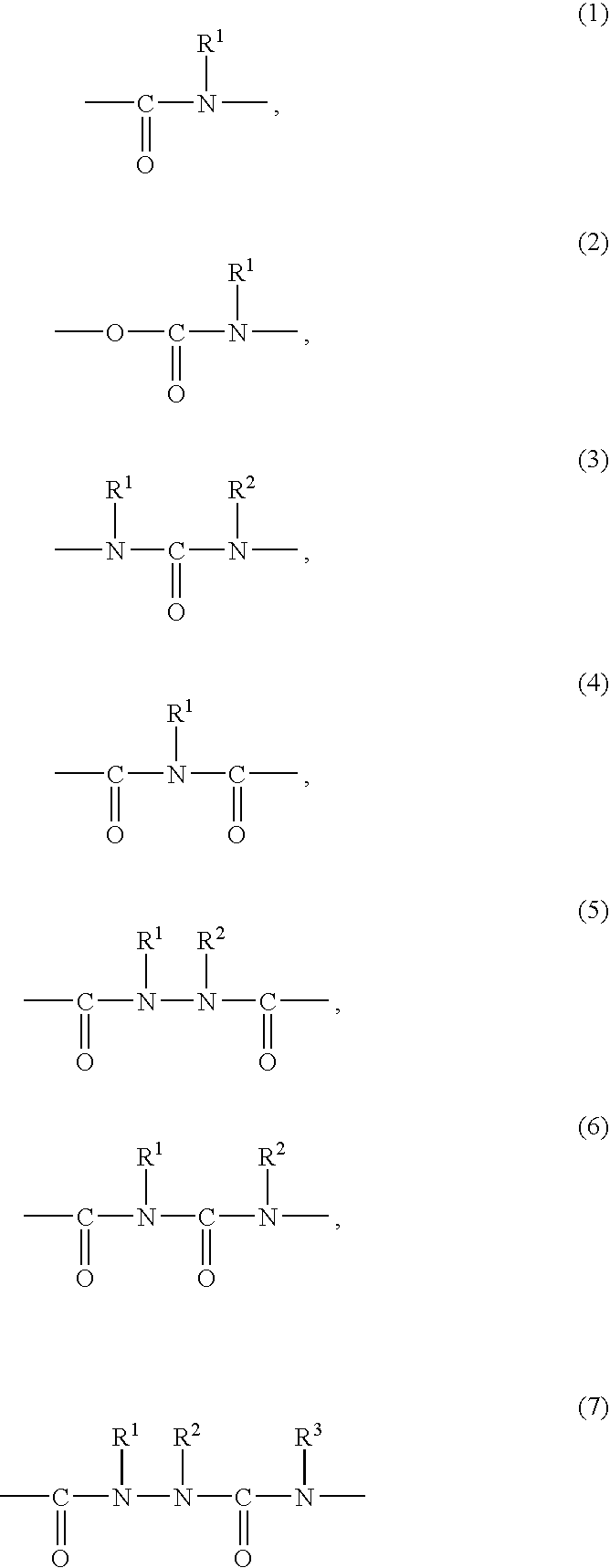Liquid crystal alignment agent and liquid crystal device using the liquid crystal alignment and method for alignment of liquid crystal molecules
- Summary
- Abstract
- Description
- Claims
- Application Information
AI Technical Summary
Benefits of technology
Problems solved by technology
Method used
Image
Examples
example 4
##STR19##
Under nitrogen gas atmosphere, 0.92 g (4 mmol) of APBA and 0.60 g (4 mmol) of 4-methyl-m-aminobenzoic acid (abbreviated as Me-MABA hereafter) were dissolved in 4.75 ml of NMP, and 0.78 ml of Py and 2.52 ml of TPP were added into, this liquid solution and stirred for 19 hours after heated to 100.degree. C. Obtained reaction liquid solution was diluted with 11.6 ml of NMP and poured into excess methanol, and polymer precipitated were filtered and dried. The procedures above were repeated and purified, and 1.49 g of polyamide shown in the structural formula PA-4 above was obtained. Number-average molecular weight and weight-average molecular weight of PA-4 obtained through the gel permeation chromatography were 1.06.times.10.sup.4 and 1.89.times.10.sup.4, respectively.
example 5
##STR20##
Under argon gas atmosphere, 0.20 g (1.458 mmol) of p-amino benzoic acid (abbreviated as PABA hereafter) and 0.30 g (2.188 mmol) of MABA were dissolved in 1.31 ml of NMP, and 0.31 ml of Py and 1.00 ml of TPP were added into this liquid solution and stirred for 18 hours after heated to 100.degree. C. The reaction liquid solution thus obtained was diluted with 4 ml of NMP and then poured into 50 ml of excess methanol, and polymer precipitated were filtered and dried. The procedures above were repeated and purified, and 0.412 g of polyamide shown in the structural formula PA-5 was obtained. Number-average molecular weight and weight-average molecular weight of PA-5 obtained through the gel permeation chromatography were 6.74.times.10.sup.3 and 1.26.times.10.sup.4, respectively.
example 6
##STR21##
Under argon gas atmosphere, 0.27 9 (2.0 mmol of PABA and 0.30 9 (2.0 mmol) of Me-MABA were dissolved in 1.33 ml of NMP, and 0.39 ml of Py and 1.26 ml of TPP were added into this liquid solution and stirred for 18 hours after heated to 100.degree. C. Reaction liquid solution thus obtained was diluted with 4 ml of NMP and then poured into 50 ml of excess methanol, and polymer precipitated were filtered and dried. The procedures above were repeated and purified, and 0.480 g of polyamide shown in the structural formula PA-6 above was obtained. Number-average molecular weight and weight-average molecular weight of PA-6 obtained through the gel permeation chromatography were 7.56.times.10.sup.3 and 2.52.times.10.sup.4, respectively.
PUM
| Property | Measurement | Unit |
|---|---|---|
| Fraction | aaaaa | aaaaa |
| Fraction | aaaaa | aaaaa |
| Fraction | aaaaa | aaaaa |
Abstract
Description
Claims
Application Information
 Login to View More
Login to View More - R&D
- Intellectual Property
- Life Sciences
- Materials
- Tech Scout
- Unparalleled Data Quality
- Higher Quality Content
- 60% Fewer Hallucinations
Browse by: Latest US Patents, China's latest patents, Technical Efficacy Thesaurus, Application Domain, Technology Topic, Popular Technical Reports.
© 2025 PatSnap. All rights reserved.Legal|Privacy policy|Modern Slavery Act Transparency Statement|Sitemap|About US| Contact US: help@patsnap.com



